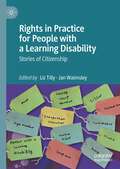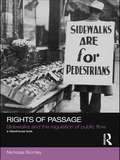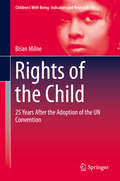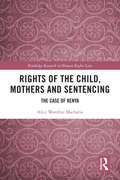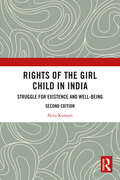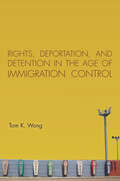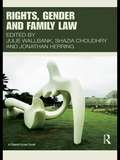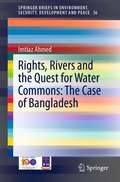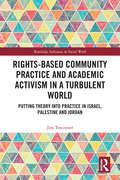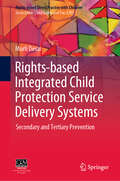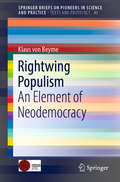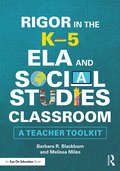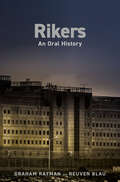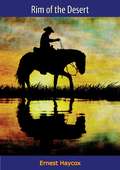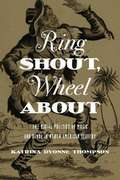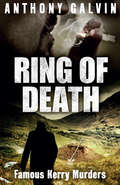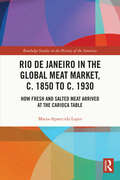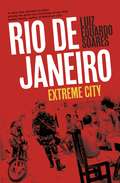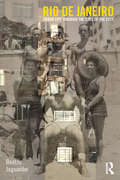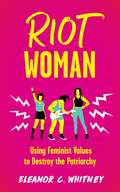- Table View
- List View
Rights for Robots: Artificial Intelligence, Animal and Environmental Law
by Joshua C. GellersBringing a unique perspective to the burgeoning ethical and legal issues surrounding the presence of artificial intelligence in our daily lives, the book uses theory and practice on animal rights and the rights of nature to assess the status of robots. Through extensive philosophical and legal analyses, the book explores how rights can be applied to nonhuman entities. This task is completed by developing a framework useful for determining the kinds of personhood for which a nonhuman entity might be eligible, and a critical environmental ethic that extends moral and legal consideration to nonhumans. The framework and ethic are then applied to two hypothetical situations involving real-world technology—animal-like robot companions and humanoid sex robots. Additionally, the book approaches the subject from multiple perspectives, providing a comparative study of legal cases on animal rights and the rights of nature from around the world and insights from structured interviews with leading experts in the field of robotics. Ending with a call to rethink the concept of rights in the Anthropocene, suggestions for further research are made. An essential read for scholars and students interested in robot, animal and environmental law, as well as those interested in technology more generally, the book is a ground-breaking study of an increasingly relevant topic, as robots become ubiquitous in modern society.
Rights in Practice for People with a Learning Disability: Stories of Citizenship
by Liz Tilly Jan WalmsleyThis book aims to raise awareness about the possibility of achieving the goals of the United Nations Convention on the Rights of Persons with Disabilities (UNCRPD), in order for all disabled people to enjoy the benefit of human rights. The stories of people who have been supported to enjoy their rights and their citizenship will enable readers to focus on how services and support can enable people with a learning disability to have their rights upheld, with an outcome of citizenship, independence and achievement. Despite the UNCRDP being in place since 2006, a significant number of learning disability service provider organisations and professionals in the UK are not aware of its existence. This book aims to bridge the gap between policy and practice to demonstrate the value of a human rights approach as the foundation for services and support for people with a learning disability.
Rights of Passage: Sidewalks and the Regulation of Public Flow (Social Justice)
by Nicholas BlomleyRights of Passage: Sidewalks and the Regulation of Public Flow documents a powerful and under-researched form of urban governance that focuses on pedestrian flow. This logic, which Nicholas Blomley terms 'pedestrianism', values public space not in terms of its aesthetic merits, or its success in promoting public citizenship and democracy. Rather, the function of the sidewalk is understood to be the promotion and facilitation of pedestrian flow and circulation, predicated on the appropriate arrangement of people and objects. This remarkably pervasive yet overlooked logic shapes the ways in which public space is regulated, conceived of, and argued about. Rights of Passage shows how the sidewalk is literally produced, encoded, rendered legible and operational with reference to a dense array of codes, diagrams, specifications, academic and professional networks, engineering rubrics, regulation and case law – all in the name of unfettered circulation. Although a powerful form of governance, pedestrianism tends to be obscured by grander and more visible forms of urban regulation. The rationality at work here may appear commonplace; but, precisely because it is uncontroversial, pedestrianism is able to operate below the academic and political radar. Complicating the prevailing tendency to focus on the socially directive nature of public space regulation, Blomley reveals the particular ways in which pedestrianism deactivates rights-based claims to public space.
Rights of the Child
by Brian MilneThis work reviews the progress of children's rights 25 years since the adoption of the UN Convention on the Rights of the Child. It studies the progress of that human rights instrument as part of an ongoing process. It examines how recent past, present and future generations will benefit or suffer as part of the process in which outcomes cannot be predicted. It does not project into the future. Its emphasis is on a review of the period after 1989 and it comments on what has happened and offering guidance on how children's rights might progress. The book presents a realistic but not always critical review of two and a half decades of intensive activity in the field of children's rights worldwide. It includes both failures and examples of good practice and positive experiences. It offers a review of progress and lack of progress in child rights and welfare in the twelve countries used as case studies in its predecessor, The Next Generation. Finally, the volume considers the impact of current geopolitical and economic realities on children's rights in the early years of the twenty-first century. The book is a tribute to Judith Ennew and pays homage to all of the people who have contributed so much to children's rights over the years and wishes to encourage others to take up the cause.
Rights of the Child, Mothers and Sentencing: The Case of Kenya (Routledge Research in Human Rights Law)
by Alice Wambui MachariaThis book draws international attention to the autonomy of the child accompanying incarcerated mothers, and those they leave behind in the community, despite being dependent on the convicted caregiver. Adopting a child rights perspective, the study explores how courts could go about sentencing mothers of young children for the commission of criminal offences, whilst protecting the rights of the child as envisaged under the United Nations Convention on the Rights of the Child (UNCRC). Drawing on the author’s experience as a sentencer in the Kenyan court and with reference to domestic, regional and international law, the book argues that children’s rights are presently left in abeyance when their mothers are sentenced to imprisonment, and that greater efforts should be made to recognize and give effect to the child’s existence as an autonomous equal holder of human rights, despite being dependent on the convicted caregiver. It explores the application of precedence as well as the court’s discretion in view of the dependent child, and concludes that policy reform in this respect calls for change in attitude and approach on women and children’s issues. Observing that internationally, most women imprisoned with their children fall beneath the custodial threshold set by law, the research examines how current sentencing practices could be reformed, and suggests harnessing the Power of Mercy Committee, the Sentencing Guidelines and progressive practices from developed countries in protecting the child’s rights by imposing non-custodial sentences for the offending mothers. It is concluded that in all jurisdictions, strict accountability for the dependent child should be situated with the judiciary, and that the same should be pronounced as a mandatory legal requirement. The book will be a valuable resource for academic, researchers and policy-makers working in the area of international children’s rights law and criminal law.
Rights of the Girl Child in India: Struggle for Existence and Well-Being
by Nitu KumariThis book discusses regional and global discourses on the rights of children, especially girls. It focuses on social and government initiatives to address the marginalization of women and girls in societies across the world.It traces the root causes for the vulnerable positions of girls and women and the challenges associated with improving their access to opportunities, education, healthcare and socio-economic freedoms. It explores national and international initiatives for the welfare and development of the girl child and recent social, legal and policy developments towards uplifting vulnerable girls in largely patriarchal societies in India. It looks at debates over age and rights; the status of the girl child; the causes and consequences of being vulnerable; various aspects of welfare and protection and the cultural relativism and violation of human rights of girls and women.An important volume on human rights, this book will be of interest to students, researchers and practitioners of gender studies, sociology of the family, human rights, law and civil liberties, development studies, socio-legal studies, and sociology and social policy.
Rights, Deportation, and Detention in the Age of Immigration Control
by Tom K. WongImmigration is among the most prominent, enduring, and contentious features of our globalized world. Yet, there is little systematic, cross-national research on why countries "do what they do" when it comes to their immigration policies. Rights, Deportation, and Detention in the Age of Immigration Control addresses this gap by examining what are arguably the most contested and dynamic immigration policies--immigration control--across 25 immigrant-receiving countries, including the U. S. and most of the European Union. The book addresses head on three of the most salient aspects of immigration control: the denial of rights to non-citizens, their physical removal and exclusion from the polity through deportation, and their deprivation of liberty and freedom of movement in immigration detention. In addition to answering the question of why states do what they do, the book describes contemporary trends in what Tom K. Wong refers to as the machinery of immigration control, analyzes the determinants of these trends using a combination of quantitative analysis and fieldwork, and explores whether efforts to deter unwanted immigration are actually working.
Rights, Gender and Family Law
by Jonathan Herring Julie Wallbank Shazia ChoudhryThere has been a widespread resurgence of rights talk in social and legal discourses pertaining to the regulation of family life, as well as an increase in the use of rights in family law cases, in the UK, the US, Canada and Australia. Rights, Gender and Family Law addresses the implications of these developments – and, in particular, the impact of rights-based approaches upon the idea of welfare and its practical application. There are now many areas of family law in which rights and welfare based approaches have been forced together. But whilst, to many, they are premised upon different ethics – respectively, of justice and of care – for others, they can nevertheless be reconciled. In this respect, a central concern is the 'gender-blind' character of rights-based approaches, and the ontological and practical consequences of their employment in the gendered context of the family. Rights, Gender and Family Law explores the tensions between rights-based and welfare-based approaches: explaining their differences and connections; considering whether, if at all, they are reconcilable; and addressing the extent to which they can advantage or disadvantage the interests of women, children and men. It may be that rights-based discourses will dominate family law, at least in the way that social policy and legislation respond to calls of equality of rights between mothers and fathers. This collection, however, argues that rights cannot be given centre-stage without thinking through the ramifications for gendered power-relations, and the welfare of children. It will be of interest to researchers and scholars working in the fields of family law, gender studies and social welfare.
Rights, Religion and Reform: Enhancing Human Dignity through Spiritual and Moral Transformation
by Chandra MuzaffarThis book discusses issues concerning human rights and religion. Is a more integrated approach to human rights desirable - an approach that transcends the individual-centred orientation of civil and political liberties of the dominant centres of power in the West? How can religious thought contribute to an integrated notion of human rights and human dignity? What sort of transformation should religion itself undergo in order to enable it to come to grips with contemporary challenges? Related to this is a larger question: How can universal spiritual and moral values help to shape politics, the economy and society as a whole?
Rights, Rivers and the Quest for Water Commons: The Case of Bangladesh (SpringerBriefs in Environment, Security, Development and Peace #36)
by Imtiaz AhmedRight to water may sound novel and somewhat dramatic, yet it has been central to the quest of human civilization for thousands of years. One of the earliest references to water as ‘common property’ can be found in the Jewish laws as early as 3000 BCE.Similar views are also found in Islam. In fact, the Arabic word for Islamic law - shari’ah - originally meant “the place from which one descends to water.”Since water is a gift from the divine to all living beings, sharing water is regarded as holy duty. This is found across religions, regions, societies, and communities, from New Zealand to Nigeria, from Bangladesh to Brazil. But then, what transformed the divine sanction? What led to the negation of the ‘commons,’ with sharing of the riverine water across territorial boundaries suffering the most?The answer probably lies as much as in the politics of safeguarding one’s personal or national interests as it is in the limitations imposed by our disciplinary understanding of things.In this context, a thorough reexamination, even reconceptualization,of some of the core issuesis required.Firstly, the concept of water needs to be understood not as H2O, as it is done in physical sciences,but as H2OP4. That is, the meaning of water in social sciences must include not only ‘twice hydrogen plus oxygen’ but also four P’s - pollution, power, politics and profit. This is not to discount the ‘science’ in the conceptualization of water but rather to add elements central to social sciences.Secondly, the concept of river needs to be redefined and understood not as a carrier of water, as assumedin most of theWestern languages, but as ‘nadi,’ a flow consisting of prana (life), shakti (power), and atman (soul), as etymologically definedin most of the South Asian languages. This comes closer to what critical hydrologists would say, WEBS, that is, a ‘river’ consists of water, energy, biodiversity and sediment. In this light, any fragmentation of transboundary river waterin the name of ‘sharing’becomes an unworkable option, unless of course a mechanism is found to ‘share’the water of the river along with its energy, biodiversity and sediment, and that again, without distorting and harming the life of the river!Thirdly, the subject of ‘water commons’needs to be approached from the standpoint of ‘rights’ of both human andriver. This is to flag the notion that nature, including rivers, has ‘rights’just like humans, although their manifestations may be different. In fact, empowered humans, particularly those in control of the state, have more ‘responsibility’ than ‘rights’ in dissuading themselves and others from creating conditions of human wrongs, not only against fellow human beings but also against nature.Finally, if the ‘rights’ ofhumans are to be ensuredthen there is an urgent need to reconceptualize and mainstream the human as a multiverse being. This is because humans are not only political beings but also economic, cultural, ecological, technological, and psychological beings. In this light, if conflicts are to be contained then humans need to be empowered in all possible areasof life – politics, economics, ecology, culture, technology, and psychology. This would certainly require empowering each and every person, all at the same time receptive to nature in general and rivers in particular.The book is designed to initiate a discourse on the civilizational quest for water commons, indeed, with the expectation that a discussion on rights and rivers would lead to a creative flow of ideas and practices.
Rights-Based Community Practice and Academic Activism in a Turbulent World: Putting Theory into Practice in Israel, Palestine and Jordan (Routledge Advances in Social Work)
by Jim TorczynerDrawing on a theoretical model of coexistence premised on universality, reciprocity and inclusion, this book focusses on the development of academic social work programs and cross-border partnerships to promote social justice and peace in Israel, Palestine, and Jordan. Using the model of rights-based practice initiated by Professor Torczyner in Montreal and brought to the Middle East in the 1990s, it shows how the creation and brokering of cross-border partnerships added the concept of rights-based practice to the lexicon of these countries, established groundbreaking advocacy centers in the hearts of disadvantaged communities, developed academic social work programs, and initiated important policy changes in each country to reduce inequality and promote social inclusion. Showing how this evolving method of rights-based practice rooted in theories of coexistence was uniquely adapted in different contexts and cultures while negotiating complex, volatile political environments, it illustrates how long-term peace can be advanced when like-minded people —irrespective of nationality or religion—find ways to promote common interest and a regional culture where all people share the same rights. This book will be of interest to all social work students and practitioners interested in community organization and rights-based practice, as well as scholars, policy makers and practitioners of international development, political science, peace studies, Jewish studies, Middle Eastern studies, reconciliation, and conflict resolution.
Rights-based Integrated Child Protection Service Delivery Systems: Secondary and Tertiary Prevention (Rights-based Direct Practice with Children)
by Murli DesaiThe Sourcebook-IV provides training modules for rights-based integrated child protection service delivery systems at the secondary and tertiary prevention levels. Part 1 of the Sourcebook focuses on the preventative, comprehensive, integrated and systemic, and universal community-based and family-based service delivery systems for children; and the methods of case management and outcomes-based project cycle. Part 2 discusses children and families at risk and the role of community-based Integrated Childcare and Support Centres for providing supplementary care and support services to them at the secondary prevention level. It also focuses on children facing sociolegal problems such as deprivation of parental care, violence, and conflict with law, and the role of District-based Integrated Child Protection Centres for providing protection, justice and rehabilitation to them at the tertiary prevention level. Part 3 focuses on children in emergencies in general and in specific situations and role of Integrated Child Protection Centres in these situations. This is a necessary read for social workers, lawyers, researchers, trainers and teachers working on child rights across the world, and especially in developing countries.
Rightwing Populism: An Element of Neodemocracy (SpringerBriefs on Pioneers in Science and Practice #40)
by Klaus Von BeymeThis book, written by a prominent German political scientist and specialist for political theory and comparative government, analyses right-wing populism as a topical theme of postmodern party systems in Europe and the United States.
Rigor in the K–5 ELA and Social Studies Classroom: A Teacher Toolkit
by Barbara R. Blackburn Melissa MilesLearn how to incorporate rigorous activities into your English language arts or social studies classroom and help students reach higher levels of learning. Expert educators and consultants Barbara R. Blackburn and Melissa Miles offer a practical framework for understanding rigor and provide specialized examples for elementary ELA and social studies teachers. Topics covered include: Creating a rigorous environment High expectations Support and scaffolding Demonstration of learning Assessing student progress Collaborating with colleagues The book comes with classroom-ready tools, offered in the book and as free eResources on our website at www.routledge.com/9781138598959.
Rigorism of Truth: "Moses the Egyptian" and Other Writings on Freud and Arendt (signale|TRANSFER: German Thought in Translation)
by Hans BlumenbergIn "Moses the Egyptian"—the centerpiece of Rigorism of Truth, the German philosopher Hans Blumenberg addresses two defining figures in the intellectual history of the twentieth century: Sigmund Freud and Hannah Arendt. Unpublished during his lifetime, this essay analyzes Freud’s Moses and Monotheism (1939) and Arendt’s Eichmann in Jerusalem (1963), and discovers in both a principled rigidity that turns into recklessness because it is blind to the politics of the unknown.Offering striking insights into the importance of myth in politics and the extent to which truth can be tolerated in adversity, the essay also provides one of the few instances where Blumenberg reveals his thinking about Judaism and Zionism. Rigorism of Truth also includes commentaries by Ahlrich Meyer that give a fuller understanding of the philosopher’s engagement with Freud, Arendt, and the Eichmann trial, as well as situating these reflections in the broader context of Blumenberg’s life and thought.
Rikers: An Oral History
by Graham Rayman Reuven BlauA shocking, groundbreaking oral history of the infamous Rikers jail complex and an unflinching portrait of injustice and resilience told by the people whose lives have been forever altered by it &“This mesmerizing and gut-wrenching book shows the brutal realities that tens of thousands of people have been forced to navigate, and survive, in America&’s most notorious jail.&”—Piper Kerman, New York Times bestselling author of Orange is the New BlackWhat happens when you pack almost a dozen jails, bulging at the seams with society&’s cast-offs, onto a spit of landfill purposefully hidden from public view? Prize-winning journalists Graham Rayman and Reuven Blau have spent two years interviewing more than 130 people comprising a broad cross section of lives touched by New York City's Rikers Island prison complex—from incarcerated people and their relatives, to officers, lawyers, and commissioners, with stories spanning the 1970s to the present day. The portrait that emerges calls into question the very nature of justice in America. Offering a 360-degree view inside the country&’s largest detention complex, the deeply personal accounts—featured here for the first time—take readers on a harrowing journey into every corner of Rikers, a failed society unto itself that reflects society&’s failings as a whole. Dr. Homer Venters was shocked by the screams on his first day working at Rikers: &“They&’re in solitary, just yelling . . . the yelling literally never stops.&” After a few months, though, Dr. Venters notes, one's ears adjust to the sounds. Nestor Eversley recalls how detainees made weapons from bones. Barry Campbell recalls hiding a razor blade in his mouth—&“just in case&”. These are visceral stories of despair, brutality, resilience, humor, and hope, told by the people who were marooned on the island over the course of decades. As calls to shutter jails and reduce the number of incarcerated people grow louder across the country, with the movement to close the island complex itself at the forefront, Rikers is a resounding lesson about the human consequences of the incarceration industry.
Rilevando emozioni: Scopri i poteri del linguaggio del corpo
by Danilo H. GomesPoche persone possono leggere facilmente i gesti umani. Questo è un compito che richiede osservazione e concentrazione. Tuttavia, l'interpretazione del linguaggio del corpo è possibile per coloro che hanno le conoscenze necessarie. RILEVANDO EMOZIONI contiene l'ideale per chi vuole apprendere, in modo rapido e diretto, i significati nascosti dietro ogni movimento umano. Conoscere più profondamente il linguaggio del corpo: parti del corpo, possemica, segni della menzogna/verità e prime impressioni. Imparate a leggere i gesti umani con facilità, conoscendo i punti fondamentali del linguaggio del corpo.
Rim of the Desert
by Ernest HaycoxTHE LAW OF LEAD IN THE WESTThe Broken Bit boys shot Sheriff Ben Borders after the nesters and law-abiders had re-elected him. Old Ben lay dying on the courthouse steps with Jim Keene looking down at him.“You stayin’?” said Ben.“I’ll be staying,” said Jim.“Well, when you get to the other side of the hill—remember this, son—the only thing you’ll find there is just what you brought with you.”Jim Keene had ridden a thousand miles to get to Cloud Valley and away from trouble. He was a strong man and a fighting man, but he always took sides. He couldn’t help fighting for the underdog. And when he got to Cloud Valley he found that he couldn’t run away from himself.With the sheriff dead, there was no law. So Jim Keene dealt himself in on the fight—on the side of the weak—and shot his way to justice…
Ring Shout, Wheel About: The Racial Politics of Music and Dance in North American Slavery
by Katrina Dyonne ThompsonIn this ambitious project, historian Katrina Thompson examines the conceptualization and staging of race through the performance, sometimes coerced, of black dance from the slave ship to the minstrel stage. Drawing on a rich variety of sources, Thompson explicates how black musical performance was used by white Europeans and Americans to justify enslavement, perpetuate the existing racial hierarchy, and mask the brutality of the domestic slave trade. Whether on slave ships, at the auction block, or on plantations, whites often used coerced performances to oppress and demean the enslaved. As Thompson shows, however, blacks' "backstage" use of musical performance often served quite a different purpose. Through creolization and other means, enslaved people preserved some native musical and dance traditions and invented or adopted new traditions that built community and even aided rebellion. Thompson shows how these traditions evolved into nineteenth-century minstrelsy and, ultimately, raises the question of whether today's mass media performances and depictions of African Americans are so very far removed from their troublesome roots.
Ring of Death: Famous Kerry Murders
by Anthony GalvinTo all appearances, Kerry is an idyllic tourist destination. Yet scratch beneath its scenic surface and the sordid secrets of the county known as 'the Kingdom’ flow free like blood . . .Some of the most notorious murders in the history of Ireland have taken place in Kerry, including a two-day orgy of slaughter perpetrated by state forces during the Civil War. Another is the case of two farmers fighting over a patch of land not big enough to accommodate a picnic blanket, resulting in a killing that inspired the play and film The Field. The county’s most infamous case was the discovery of a baby stabbed to death on a beach, with another infant’s body found during the subsequent investigation. To this day, the identities of the children, their mothers and the murderer remain a mystery, but the case led to the government setting up a tribunal to investigate the Gardaí and how they had handled the inquiry.In Ring of Death, true-crime writer Anthony Galvin explores the bloody history of Kerry and the many fascinating murder cases that have occurred in the county over the past century.
Ringing The Changes
by Gill Dyer Moira Monteith Gina MitchellFirst published in 1991. Ringing the Changes is a realistic and practical guide that provides ideas, information and advice for women planning a return to work or study after a career break. Gill Dyer, Gina Mitchell and Moira Monteith draw widely upon their own experiences both as tutors and as women juggling with the conflicting demands of personal and work commitments. This hlepful book includes case studies illustrating the problems faced by women returners and exercises designed to develop communication skills and build self confidence. The text is accompanied by Angela Martin's humorous and delightful illustrations. This book should be of interest to women considering a return to work and to teachers in adult education.
Rio de Janeiro in the Global Meat Market, c. 1850 to c. 1930: How Fresh and Salted Meat Arrived at the Carioca Table
by Maria-Aparecida LopesThis book examines the meat provision system of Rio de Janeiro from the 1850s to the 1930s. Until the 1920s, Rio was Brazil’s economic hub, main industrial city, and prime consumer market. Meat consumption was an indicator of living standards and a matter of public concern. The work unveils that in the second half of the nineteenth century, the city was well supplied with red meat. Initially, dwellers relied mostly on salted meat; then, in the latter decades of the 1800s, two sets of changes upgraded fresh meat deliveries. First, ranching expansion and transportation innovation in southeast and central-west Brazil guaranteed a continuous flow of cattle to Rio. Second, the municipal centralization of meat processing and distribution made its provision regular and predictable. By the early twentieth century, fresh meat replaced salted meat in the urban marketplace. This study examines these developments in light of national and global developments in the livestock and meat industries.
Rio de Janeiro: Extreme City
by Luiz Eduardo SoaresA book as rich and sprawling as the seductive metropolis it evokes, Rio de Janeiro builds a kaleidoscopic portrait of this city of extremes, and its history of conflict and corruption. Award-winning novelist, ex-government minister and sociologist, Luiz Eduardo Soares tells the story of Rio through the everyday lives of its people: gangsters and police, activists, politicians and struggling migrant workers, each with their own version of the city. Taking us on a journey into Rio's intricate world of favelas, beaches and corridors of power, Soares reveals one of the most extraordinary cities in the world in all its seething, agonistic beauty.
Rio de Janeiro: Urban Life through the Eyes of the City (CRESC)
by Beatriz Jaguaribe"Through artistic imaginaries, media productions, social practices and spatial mappings, this book offers an insightful and original contribution to the understanding of Rio de Janeiro, one of the highly contested urban terrains in the world. Offering a rich diversity of examples extracted from lived experience, iconographic materials, and narratives, it provides innovative and compelling connections between theoretical questions and urban vignettes. Throughout the essays, the specificity of Rio de Janeiro is highlighted but framed in relation to theoretical questions that are relevant to major contemporary cities. The book underlines the dilemmas of a city that attempts to compete globally while confronting social inequality, violence, and novel forms of democratic agency. It retraces Rio de Janeiro’s modernist memories as the former political/cultural capital of Brazilian intelligentsia and national culture. It explores Rio as a city of popular culture, mestizo legacies, media productions, and cultural innovation."
Riot Woman: Using Feminist Values to Destroy the Patriarchy
by Eleanor C. WhitneyGrowing up immersed in the feminist, DIY values of punk, Riot Grrrl, and zine culture of the 1990s and early 2000s gave Eleanor Whitney, like so many other young people who gravitate towards activism and musical subcultures, a sense of power, confidence, community, and social responsibility. As she grew into adulthood she struggled to stay true to those values, and with the gaps left by her punk rock education. This insightful, deeply personal history of early-2000s subcultures lovingly explores the difficulty of applying feminist values to real-life dilemmas, and embrace an evolving political and personal consciousness. Whitney traces the sometimes painful clash between her feminist values and everyday, adult realities — and anyone who has worked to integrate their political ideals into their daily life will resonate with the histories and analysis on these pages, such as engaging in anti-domestic violence advocacy while feeling trapped in an unhealthy relationship, envisioning a unified "girl utopia" while lacking racial consciousness, or espousing body positivity while feeling ambivalent towards one's own body. Throughout the book, the words and power of Bikini Kill and other Riot Grrrl bands ground the story and analysis, bringing it back to the raw emotions and experiences that gave this movement its lasting power while offering a complex, contemporary look at the promises and pitfalls of Riot Grrrl-informed feminism.

